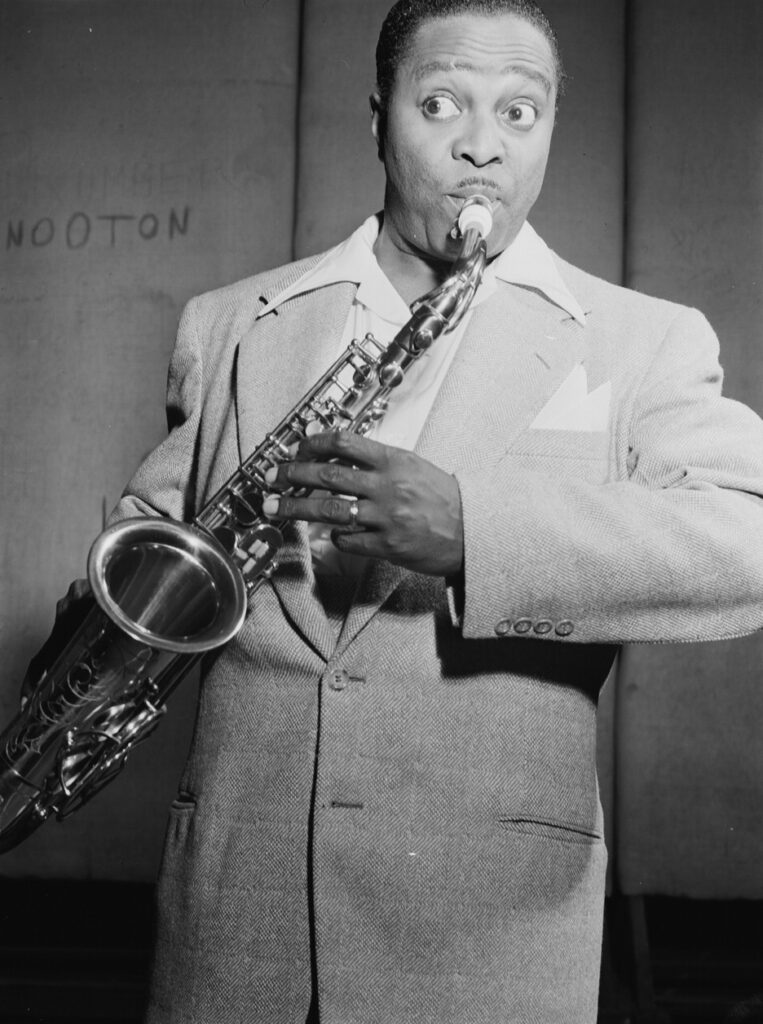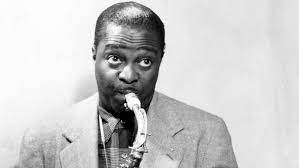Louis Jordan – A Complete Biography
Introduction
Louis Thomas Jordan (July 8, 1908 – February 4, 1975) was an American alto-saxophonist, singer, songwriter, and bandleader whose witty, tight ensemble recordings and stagecraft made him one of the most popular entertainers of the 1940s. Nicknamed “The King of the Jukebox,” Jordan led the Tympany Five and blended swing, blues, and boogie-woogie into a spirited style—jump blues—that directly shaped rhythm & blues and helped pave the way for rock and roll. His clever lyrics, danceable arrangements, and comic stage persona made him a crossover favorite with Black and white audiences and placed numerous records atop the R&B charts in the 1940s.

Childhood
Louis Jordan was born in Brinkley, Arkansas, on July 8, 1908, the son of Thomas Jordan and Lucille Anderson. His family moved frequently in his early years; Jordan spent parts of his childhood in Arkansas and Georgia. Music was present in the household—his father was a talented musician who played various instruments—which exposed Louis to both secular and sacred music and encouraged his early interest in performance. As a youth he sang in church choirs and learned instruments; the combination of rural Southern musical traditions and early urban experiences shaped his later stylistic blend of blues and swing.
Youth
In his teens and early twenties Jordan left the rural South for the North, eventually settling in cities where he could pursue a musical career. He studied at various schools and briefly attended college, but music pulled him away from formal education. By the early 1930s Jordan was working as a professional musician: he played in territory bands and worked as a sideman with established jazz and swing players. He steadily honed his command of the alto saxophone and developed a knack for comedic lyrics and stage patter that would become a hallmark of his performances. These years of itinerant work gave Jordan both technical skill and a deep understanding of audience tastes.
Adulthood and Rise to Prominence
Louis Jordan’s professional breakthrough came when he formed his own small combo, the Tympany Five, in the late 1930s. Unlike the large swing orchestras of the era, Jordan’s compact group produced punchy, rhythm-driven recordings that emphasized tight ensemble playing, call-and-response vocals, and lively sax solos. The Tympany Five’s records—featuring Jordan’s vocal lead and saxophone—proved irresistible on jukeboxes and radio. During the 1940s Jordan enjoyed a string of hits and enormous popularity: he placed a remarkable number of singles on the R&B charts, many reaching number one, and his records routinely crossed over to broader audiences. Jordan also appeared in short films and feature pictures, bringing his performance style to moviegoers and expanding his influence beyond records and live shows. His combination of musical skill, comic timing, and savvy showmanship made him one of the most bankable Black entertainers of his era.
Musical Style and Influence
Louis Jordan’s music mixed swing-era phrasing with blues structures and a strong backbeat, creating an up-tempo, joyful sound now called jump blues. Jordan favored accessible storytelling lyrics—often humorous, sometimes roguish—and arrangements that left space for crisp saxophone riffs, piano and boogie-woogie patterns, and concise solos. That economy and emphasis on rhythm made his songs ideal jukebox fare and directly influenced later R&B artists and early rock-and-roll musicians: Chuck Berry, Bill Haley, and many others acknowledged Jordan’s impact on phrasing, song structure, and showmanship. His use of small-group instrumentation and emphasis on the backbeat are widely recognized as foundational to postwar popular music developments.
Major Compositions and Recordings
Jordan’s catalog includes numerous songs that became standards and were covered widely. Key recordings include:
- “Caldonia” (1945) — a rollicking vocal and sax-driven number that became one of his signature tunes and is preserved in the U.S. National Recording Registry for its cultural significance.
- “Choo Choo Ch’Boogie” (1946) — a wartime-era hit that combined train motifs and postwar optimism; it spent multiple weeks atop the R&B charts and remains a jump-blues classic.
- “Let the Good Times Roll” (1946) — an enduring party anthem, released with “Ain’t Nobody Here but Us Chickens” on the flip side; both sides were massive sellers and remain central to Jordan’s legacy.
- “Ain’t Nobody Here but Us Chickens” and “Saturday Night Fish Fry” are additional examples of Jordan’s clever-lyric, rhythm-forward approach that connected with wartime and postwar audiences and influenced a generation of performers.
Beyond individual songs, Jordan’s sheer chart dominance in the 1940s—dozens of top R&B hits—illustrates his commercial and cultural importance. His records were staples of jukeboxes across America, which is why he earned the “King of the Jukebox” sobriquet.
Performance and Media Presence
Jordan was not only a recording artist; he was a consummate entertainer. His live shows combined tight musical execution with comic routines, storytelling, and audience engagement. He headlined clubs, theaters, and appeared in short “soundies” (music shorts) and feature films, bringing the Tympany Five’s act to visual media. Radio broadcasts, movie appearances, and national tours helped Jordan reach listeners who might not otherwise have heard Black jump blues, further widening his impact on American popular culture. His amiable stage persona and pantomime-inflected delivery influenced later showmen in R&B and rock.
Personal Life, Business, and Complications
Jordan’s career also had personal and business complications. He was married several times and at points used behind-the-scenes arrangements—such as crediting songs to his wife—to manage contracts and royalties; those maneuvers sometimes created legal and financial headaches later on. As tastes changed in the 1950s, Jordan’s popularity declined relative to newer R&B and rock acts, though he continued to perform and record. He tried stylistic updates and took advantage of nostalgia and revival circuits in later decades, but his commercial peak remained in the 1940s.
Death
Louis Jordan died in Los Angeles, California, on February 4, 1975. He was 66. While his later career did not match the commercial heights of the 1940s, Jordan’s death prompted renewed assessments of his musical contributions and legacy among critics, musicians, and historians. Today his recordings are preserved in archives and retrospective compilations, and his influence is acknowledged in histories of R&B and rock and roll.
Legacy and Conclusion
Louis Jordan’s importance rests in both his music and his mode of presentation. As a composer, bandleader, and performer he fused swing-era sophistication with down-to-earth humor and the rhythmic pulse that would characterize postwar rhythm and blues. His records dominated jukeboxes, he provided a model for small-group R&B, and his phrasing, rhythms, and stagecraft can be traced through subsequent generations of popular music—from the R&B of the 1950s to early rock and roll and beyond. Today Jordan is remembered as a formative figure in 20th-century American music. For anyone exploring the bridge between jazz, blues, and rock, Louis Jordan’s recordings remain essential listening.

Comments are closed